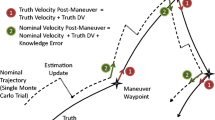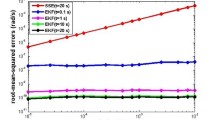Abstract
The problem of estimating relative pose and angular velocity for uncooperative space objects has garnered great interest, especially within applications such as asteroid mapping and satellite servicing. This paper provides a batch estimator based on orientation measurements to estimate not only the angular velocity magnitude and spin-axis direction of a target body (either external or oneself) undergoing pure-spin, but also the associated uncertainty bounds for the resulting angular velocity magnitude and spin-axis direction estimates under reasonable assumptions. In addition, this paper derives statistics for the third eigenvalue of the stacked measurement matrix, which enable detection of whether the target body’s spin-axis direction is changing. The statistics of the third eigenvalue are shown to match those of a Monte-Carlo-based Gamma distribution fit. Instead of a recursive filtering methodology, the batch formulation pursued in this paper is well-suited to exploit the geometric properties associated with singular value decomposition techniques and Toeplitz recursion. This batch approach relinquishes the need for an iterative scheme to compute the error bounds upon the estimated spin-axis direction.













Similar content being viewed by others
References
de Almeida, M.M., Zanetti, R., Mortari, D., Akella, M.: Real-time angular velocity estimation of non-cooperative space objects using camera measurements. In: AAS/AIAA Astrodynamics Specialist Conference, AAS 18-420 (2018)
de Almeida, M.M., Mortari, D., Zanetti, R., Akella, M.: Quatera: The quaternion regression algorithm. J. Guid. Control Dyn. 43(9), 1600–1616 (2020)
Dor, M., Tsiotras, P.: ORB-SLAM applied to spacecraft non-cooperative rendezvous. In: 2018 Space Flight Mechanics Meeting, AIAA 2018-1963 (2018)
Epps, B.P., Krivitzky, E.M.: Singular value decomposition of noisy data: Mode corruption. Exp. Fluids 60(8), 121 (2019)
Gai, E., Daly, K., Harrison, J., Lemos, L.: Star-sensor-based satellite attitude/attitude rate estimator. J. Guid. Control Dyn. 8(5), 560–565 (1985)
Kaki, S.: On-orbit Pose and Angular Velocity Estimation. The University of Texas at Austin, Master’s thesis (2020)
Kaki, S., Akella, M.R.: Uncertainty quantification for a batch filter: Estimating the angular velocity of a rigid-body in near pure-spin condition. In: 2020 AAS/AIAA Astrodynamics Specialist Conference AAS 20-652 (2020)
Kato, T.: Perturbation Theory for Linear Operators. Springer (2013)
Lefferts, E.J., Markley, F.L., Shuster, M.D.: Kalman filtering for spacecraft attitude estimation. J. Guid. Control Dyn. 5(5), 417–429 (1982)
Markley, F.L.: Attitude error representations for Kalman filtering. J. Guid. Control Dyn. 26(2), 311–317 (2003)
Melman, A.: Spectral functions for real symmetric toeplitz matrices. J. Comput. Appl. Math. 98(2), 233–243 (1998)
Mortari, D., Akella, M.: Discrete and continuous time adaptive angular velocity estimators. In: Proceedings of the AAS/AIAA Space Flight Mechanics Conference, AAS 15-254 (2015)
Nolan, M.C., Magri, C., Howell, E.S., Benner, L.A., Giorgini, J.D., Hergenrother, C.W., Hudson, R.S., Lauretta, D.S., Margot, J.L., Ostro, S.J., Scheeres, D.J.: Shape model and surface properties of the OSIRIS-REx target Asteroid (101955) Bennu from radar and lightcurve observations. Icarus 226(1), 629–640 (2013)
Schaub, H., Junkins, J.L.: Stereographic orientation parameters for attitude dynamics: A generalization of the Rodrigues parameters. J. Astron. Sci. 44(1), 1–19 (1996)
Venturi, D.: On proper orthogonal decomposition of randomly perturbed fields with applications to flow past a cylinder and natural convection over a horizontal plate. J. Fluid Mech. 559, 215 (2006)
Zisserman, R.: Hartley A.: Multiple view geometry in computer vision, 2nd edn. Cambridge University Press (2004)
Acknowledgements
This material is based upon work supported in part by the National Science Foundation Graduate Research Fellowship Program under Grant No. DGE-1610403. Any opinions, findings, and conclusions or recommendations expressed in this material are those of the author(s) and do not necessarily reflect the views of the National Science Foundation.
The authors also acknowledge research funding from the National Aeronautics and Space Administration under Grant/Contract/Agreement No. 4200732007 issued through the Johnson Space Center (Technical Point of Contact: Dr. Christopher N. D’Souza) that supported this work in part.
Author information
Authors and Affiliations
Corresponding author
Ethics declarations
Conflict of Interests
The authors declare that they have no conflict of interest.
Additional information
Publisher’s Note
Springer Nature remains neutral with regard to jurisdictional claims in published maps and institutional affiliations.
Appendix:
Appendix:
The derivation for the standard deviation of the third eigenvalue of the noisy spatiotemporal matrix is outlined as follows. As presented in Eq. 36, the noisy measurement matrix is linearized to:
which is a sum of the noise-free measurement matrix \(\bar {Z}_{n+1}\) (in Eq. 6) and a noise-induced additive error matrix ΔZn+ 1. Recall that we assume ΔZn+ 1 is composed of zero-mean, uncorrelated elements with variance ε2 (that is, for example: \({\Delta } Z_{n+1;(i,j)} \sim \mathcal {N}(0,\varepsilon ^{2}) \big )\). Here onward, the subscript (n + 1), indicating the total number of measurements, will be omitted for conciseness. The noisy spatiotemporal matrix Q := ZZT can thus be written as:
where \(\widehat {Q}^{(1)} := \bar {Z} ({\Delta } \widehat Z)^{T} + ({\Delta } \widehat Z) \bar {Z}^{T}\), and \(\widehat {Q}^{(2)} := ({\Delta } \widehat Z) ({\Delta } \widehat Z)^{T}\). Note that \({\Delta } \widehat Z := ({\Delta } Z) / \varepsilon \), so each element is a standard normal variable. Equation 73 is thus a second-order perturbation expansion of Q = ZZT. The corresponding perturbation expansion for the third eigenvalue λ3 of Q has the form:
Assuming the third eigenvalue is unique, the perturbation terms are given by [8, 15]:
where:
As shown in Venturi [15], the standard deviation of the third eigenvalue is given by:
It remains to evaluate the various third eigenvalue perturbation terms. The process involves tedious, but straightforward algebra and matrix manipulation. For example, the derivation for the first-order perturbation term \(\widehat {\lambda }_{3}^{(1)}\) is the following:

Therefore, the mean is also zero:

Following a similar derivation process:

Taking the respective means:

Thus, substituting the means into Eq. 80 results in the second-order approximation for the standard deviation of the third eigenvalue of the noisy measurement matrix:


Rights and permissions
About this article
Cite this article
Kaki, S., Akella, M.R. & Mortari, D. Angular Velocity and Covariance Estimates for Rigid Bodies in Near Pure-Spin Using Orientation Measurements. J Astronaut Sci 69, 767–800 (2022). https://doi.org/10.1007/s40295-022-00305-3
Accepted:
Published:
Issue Date:
DOI: https://doi.org/10.1007/s40295-022-00305-3




